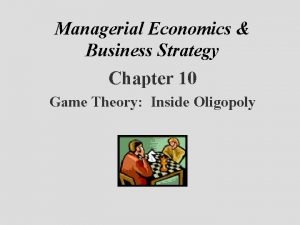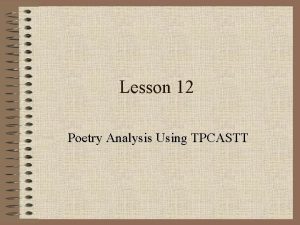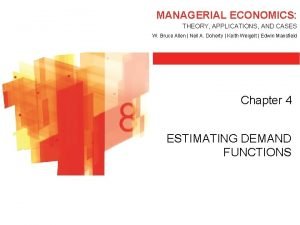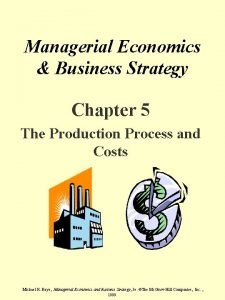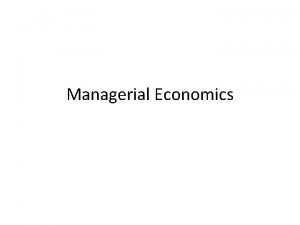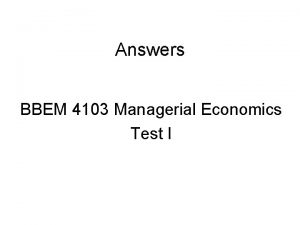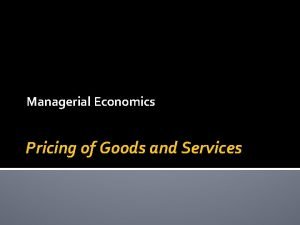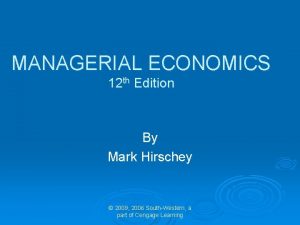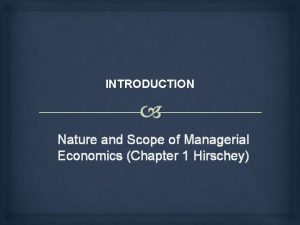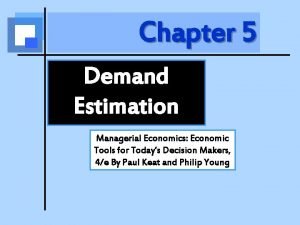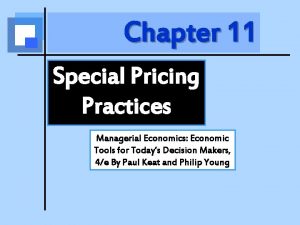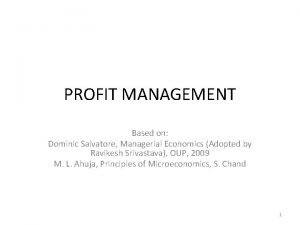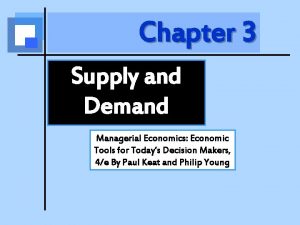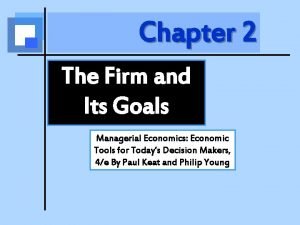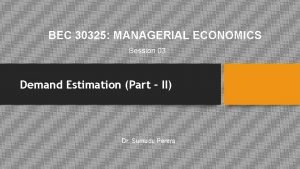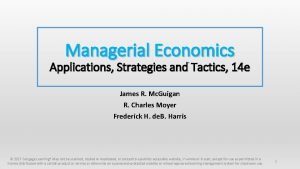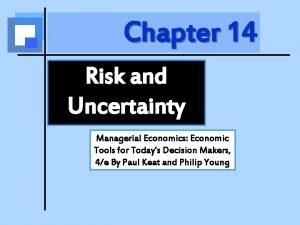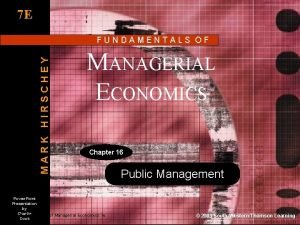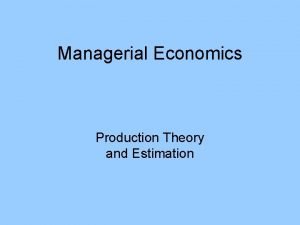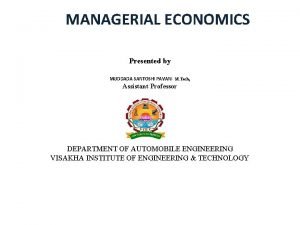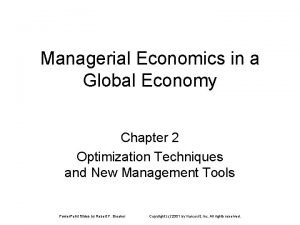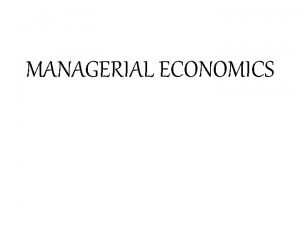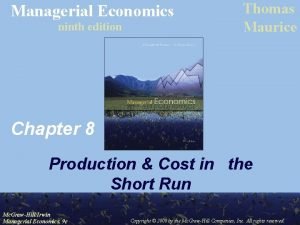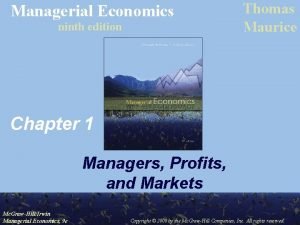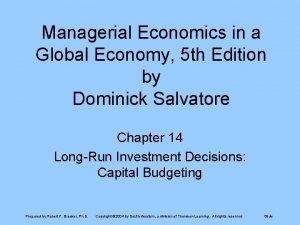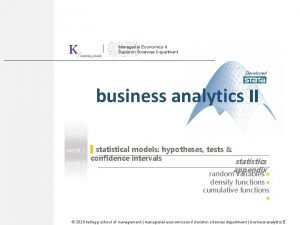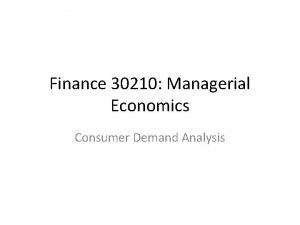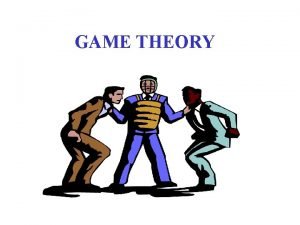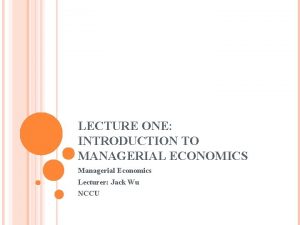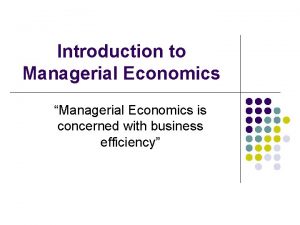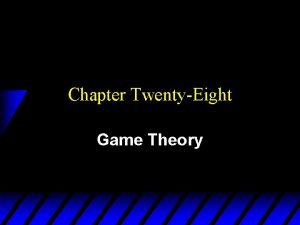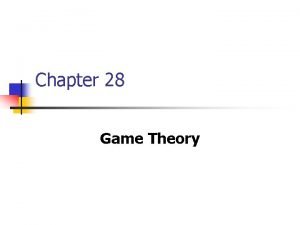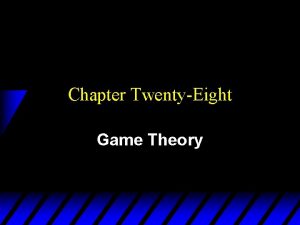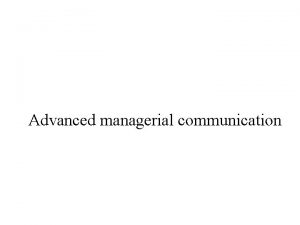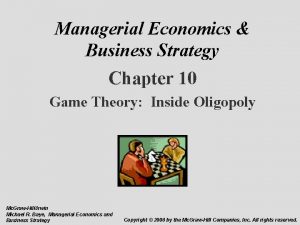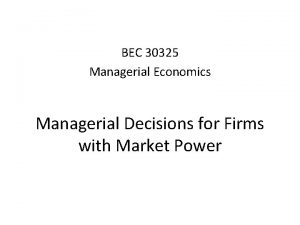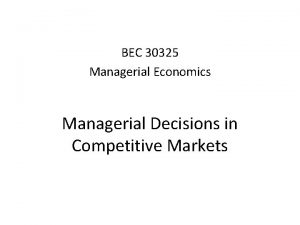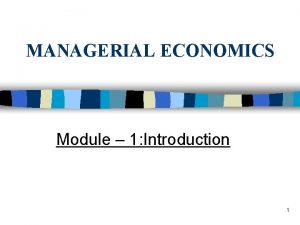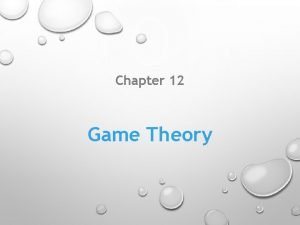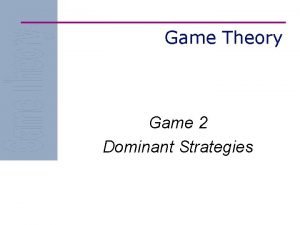Managerial Economics Todays Agenda Game Theory Chapter 9




































- Slides: 36

Managerial Economics: Today’s Agenda • Game Theory – Chapter 9 – “Strategery” – strategic interdependence – Cartels: Cooperation and Cheating – Auctions – Fun and Games – Sequential interactions – Holland Sweetener versus Monsanto, p. 245

Basic Ideas of Game Theory • Game theory is the general theory of strategic behavior. · Generally depicted in mathematical form. · Plays an important role in modern economics. Optimal decision making when all decision agents are presumed rational each attempts to anticipate actions of rivals

Rules, Strategies, Payoffs, and Equilibrium Economic situations are treated as games. · what, · The rules of the game state who can do and when they can do it. A player's strategy is a plan for actions in each possible situation in the game. · A player's payoff is the amount that the player wins or loses in a particular situation in a game. · A players has a dominant strategy if that player's best strategy does not depend on what other players do.

Nash Equilibrium • Occurs when each player's strategy is optimal, given the strategies of the other players. · A player's best response (or best strategy) is the strategy that maximizes that player's payoff, given the strategies of other players. · A Nash equilibrium is a situation in which each player makes his or her best response.

Prisoner’s Dilemma Famous example of game theory. • Strategies must be undertaken without the full knowledge of what other players will do. • Players adopt dominant strategies, but they don't necessarily lead to the best outcome.

Bonnie’s Decision Tree

• A cartel is a group of firms (members of the cartel) that try to collude to act like a monopoly and share the monopoly profit. Problems Facing Cartels • Members must be convinced to come to coincidental interests. • Production levels, or quotas, must be agreed upon. • Profits must be divided to the cartel members’ satisfaction. • Members who may cheat must be controlled.

Market Demand Industry Costs with Ten Firms P D MR Q

Market Demand Industry Costs with Ten Firms P AC MC D MR Q

Market Demand Industry Costs with Ten Firms P AC MC AC $12 MC D MR 200 Q

Market Demand Industry Costs with Ten Firms Competitive output and price P AC MC AC $12 MC D MR 200 Q

Market Demand Industry Costs with Ten Firms Competitive output and price P $18 AC MC AC $12 MC D MR 120 200 Q

Market Demand Industry Costs with Ten Firms Cartel output and price Competitive output and price P $18 AC MC AC $12 MC D MR 120 200 Q

Firm A’s Output in the Cartel P MC AC Q

Firm A’s Output in the Cartel P MC AC $12 20 Q

Firm A’s Output in the Cartel P MC AC $12 Competitive quantity and price 20 Q

Firm A’s Output in the Cartel P MC $18 AC $12 Competitive quantity and price 12 20 Q

Firm A’s Output in the Cartel Firm A’s output and price with cartel agreement P MC $18 AC $12 Competitive quantity and price 12 20 Q

Firm A’s Output in the Cartel Firm A’s output and price with cartel agreement P MC $18 AC $12 Competitive quantity and price 12 20 24 Q

Firm A’s Output in the Cartel Firm A’s output and price with cartel agreement Firm A’s output and price if MC it cheats on the cartel agreement P $18 AC $12 Competitive quantity and price 12 20 24 Q

Firm A’s Output in the Cartel Firm A’s output and price with cartel agreement Firm A’s output and price if MC it cheats on the cartel agreement P $18 AC $12 Competitive quantity and price 12 20 24 Q

Firm A’s Output in the Cartel Firm A’s output and price with cartel agreement Firm A’s output and price if MC it cheats on the cartel agreement P $18 AC $12 Extra profits earned by cheating on cartel agreement 12 20 24 Q

Cheating on a Cartel • Cartel members' possible strategies range from abiding by their agreement to cheating. · Cartel members can charge the monopoly price or a lower price. · Cheating firms can increase profits. · The best strategy is charging the low price.

Restraint of Trade and the Antitrust Laws • Antitrust laws make it illegal to restrain trade or attempt to monopolize a market. – Sherman Antitrust Act of 1890 – Clayton Act of 1914 • Executives face jail time for fixing prices or agreeing to limit competition.

Auctions • Oral versus sealed bid • First Price Auction – highest bidder pays his bid and receives object • Second Price Auction – highest bidder pays the 2 nd highest bid and receive object • First and second price Auction – First and second bidders pay, high bid wins object

Rock, Paper, Scissors • What are the elements of a game? • What are elements of the rock paper scissors game? • What is the Nash equilibrium strategies in this game?

Rock, Paper, Scissors Knowing this, we can see without the complex math that to be indifferent to all 3 options both players should play Rock, Paper and Scissors in 1/3 of their games. Normal form of Rock Paper Scissors

Seinfeld plays Kramer’s Rock, Paper, Scissors • Payoffs: – – Scissors cut paper (Scissors wins) Rock smashes scissors (Rock wins) But, rock flies straight through paper (Rock wins) Both players play the same object results in a tie • What are elements of Kramer’s rock paper scissors game? • What is the Nash equilibrium strategies in this game? • What does the rock paper scissors game teach us about baseball? Pitching? Hitting? Sitting “dead red? ”

The Auditing Game is like Rock, Paper, Scissors • Auditing and malfeasance • Employees determine whether and when to “Enron” by cooking the books or “Rigas, ” the corporation and take a ”five-finger discount? ” • Auditors determine what receives higher or lower levels of scrutiny. • Why is nobody steals and nobody audits not a Nash equilibrium? • What are the key features of a Nash equilibrium in the auditing game?

An Advertising Game Marlboro’ s Decision Advertise Marlboro gets $3 billion profit Don’t Advertise Marlboro gets $2 billion profit Advertise Camel’s Decision Don’t Advertise Camel gets $3 billion profit Marlboro gets $5 billion profit Camel gets $2 billion profit Camel gets $5 billion profit Marlboro gets $4 billion profit Camel gets $4 billion profit Does this game explain why Phillip Morris was so happy for the federal government to restrict tobacco advertising?

A Common-Resource Game Exxon’s Decision Drill Two Wells Texaco’s Decision Drill One Well Exxon gets $4 million profit Texaco gets $4 million profit Exxon gets $6 million profit Texaco gets $3 million profit Drill One Well Exxon gets $3 million profit Texaco gets $6 million profit Exxon gets $5 million profit Texaco gets $5 million profit

Why People Sometimes Can Cooperate • Firms that care about future profits will cooperate in repeated games rather than cheating in a single game to achieve a onetime gain. • Will ECON 600 students successfully form a cartel against Professor Spry? Will they all agree to turn in poor final exams, so that he will have to give everyone a large curve? – FYI, there is a reason past cartels to turn in blank exams have failed.

Sequential interactions • Boeing & Airbus communications technology choice – Boeing chooses first • Analyze with backward induction – Boeing must take Airbus’s best response into account in making its choice – Boeing has first mover advantage • Credible commitment by second mover can alter first mover choice

Extensive form sequential game

Holland Sweetener versus Monsanto, p. 245 • Construct the strategic-form payoff matrix or this strategic pricing problem. Find the Nash equilibrium. • Now assume that the interaction is sequential where Holland Sweetner chooses to enter and if so they face the pricing problem in the second stage. Should Holland Sweetner enter? • Why do you think Holland Sweetner entered? Were they just dumb or were there other potential considerations? • Prior to Holland Sweetner’s entry into the US market, Pepsi and Coke began deemphasizing the Nutra. Sweet label on their cans and bottles. Why do you think they did this? • Explain how Monsanto had a “first-mover’s advantage. ” • Pepsi and Coke were the big winners in this case. Explain why.

Looking Forward • Assignment 3 due Oct. 28, Nov. 1 or 2 • Readings: – Managerial Economics Chapters 10 and 18 (pages 503 -513) • e. Bay. com, p. 275.
 Game theory in managerial economics
Game theory in managerial economics Todays agenda
Todays agenda Methods of cost estimation in managerial economics
Methods of cost estimation in managerial economics Managerial economics: theory, applications, and cases
Managerial economics: theory, applications, and cases Ecomics
Ecomics Explain the fundamental concepts of managerial economics
Explain the fundamental concepts of managerial economics Nature and scope of macro economics
Nature and scope of macro economics Managerial economics
Managerial economics What is incremental principle
What is incremental principle Managerial economics
Managerial economics Methods of demand estimation in managerial economics
Methods of demand estimation in managerial economics Meaning of managerial economics
Meaning of managerial economics Managerial economics test questions and answers
Managerial economics test questions and answers Pricing methods in managerial economics
Pricing methods in managerial economics Managerial economics hirschey
Managerial economics hirschey What is discounting principle
What is discounting principle Managerial economics nature and scope
Managerial economics nature and scope Engineering and managerial economics
Engineering and managerial economics What is demand estimation in managerial economics
What is demand estimation in managerial economics Pricing practices in managerial economics
Pricing practices in managerial economics Profit management in managerial economics
Profit management in managerial economics Example of managerial economics
Example of managerial economics Supply analysis in managerial economics
Supply analysis in managerial economics The goal of the firm
The goal of the firm Demand estimation in managerial economics
Demand estimation in managerial economics Managerial economics applications strategy and tactics
Managerial economics applications strategy and tactics Adjusted discount rate formula
Adjusted discount rate formula Fundamentals of managerial economics
Fundamentals of managerial economics Empirical production function managerial economics
Empirical production function managerial economics Managerial economics
Managerial economics Managerial economics is called as
Managerial economics is called as Managerial economics
Managerial economics Managerial economics
Managerial economics Managerial economics
Managerial economics Managerial economics in a global economy
Managerial economics in a global economy Managerial economics and decision sciences
Managerial economics and decision sciences Managerial economics demand analysis
Managerial economics demand analysis
